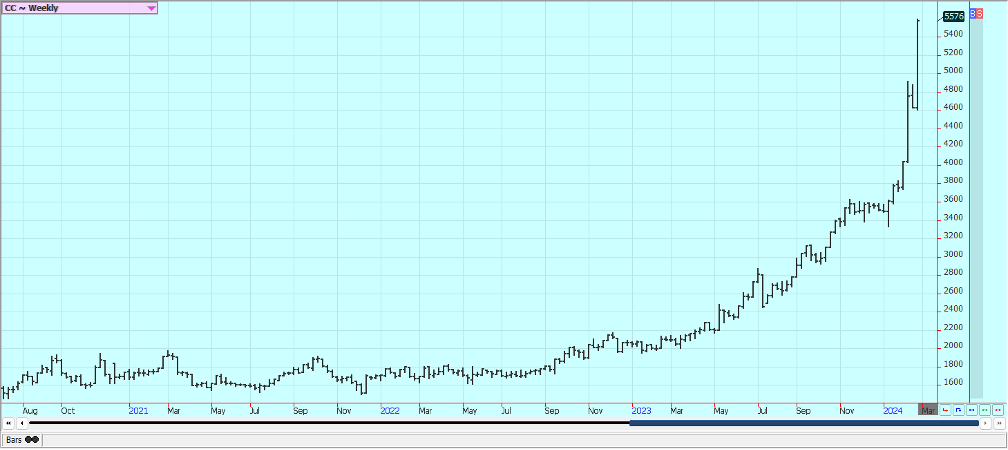Jack Scoville
Jack Scoville is an often quoted market analyst in the grain and soft commodities sectors. You will find his commentary throughout the Reuters, Wall Street Journal, Dow Jones, Bloomberg, and Barron's publications. Contact Mr. Scoville at (312) 264-4322
Translate





Weekly Ag Markets Update – 02/26/2024
Wheat: Wheat was mixed last week, with Chicago Winter What markets holding a little higher but Minneapolis Spring Wheat closing a little lower, on big world supplies and low world prices. Russian export prices were reported at a new low yesterday. Export sales remain weak on competition from Rusia, Ukraine, and the EU as those countries look to export a lot of Wheat in the coming period. EU offers were unchanged to help keep US offers from falling. Russian and Ukraine offers are weaker. Some support came from the bombings in the Red Sea that has interrupted commerce. It is warm in the US and Canada this week. Cooler temperatures are also forecast for next week. Black Sea offers are still plentiful and Russian prices appear to be weakening.
Weekly Chicago Soft Red Winter Wheat Futures
Weekly Chicago Hard Red Winter Wheat Futures
Weekly Minneapolis Hard Red Spring Wheat Futures
Corn: Corn and Oats were lower last week on big supplies and reports of limited demand. Futures are much lower than just a few months ago and a short covering rally is increasingly expected but has not come yet. Funds remain very large shorts in the market. Basis levels have started to firm in the US as processors look for supplies amid tight farmer holding patterns. The weather forecasts for Argentina are improving with more showers expected this week but coming after a hot and dry period first. On the other hand, more rain is forecast for central and northern Brazil and the Soybeans harvest could be delayed and that could mean less Corn planted area The planting progress reports to date indicate rapid progress so this concern is lessening. Soybean quality could be reduced as well. The market anticipates increased selling from US producers.
Weekly Corn Futures
Weekly Oats Futures
Soybeans and Soybean Meal: Soybeans and the products were lower and made new lows for the move last week and trends are down on the daily and weekly charts. A short covering rally is increasingly expected but has not come yet. Funds remain very large shorts in the market. Basis levels in the country are reported to be firming as processors look for supplies and farmers remain tight holders. Rains are in the forecast after the extreme weather seen over the next week in Argentina. Such rains would be beneficial for reproducing Corn and Soybeans. The precipitation keeps falling in Brazil and is expected to continue through this week. The rains could be detrimental to the quality Soybeans and the planting dates for Winter Corn. Support also came from reports of reduced Brazil production.
Weekly Chicago Soybeans Futures
Weekly Chicago Soybean Meal Futures
Rice: Rice closed higher after a wild week. The close was strong and keeps hopes for more rallies intact. Strong demand for export continues. The overseas markets feature less production in Brazil and India and it appears that the lack of offer from these markets is supporting increased demand for US Rice and prices here in the US. Warmer and wetter weather is expected this week and next on the Delta and Texas and soil moisture conditions for the next crop should improve.
Weekly Chicago Rice Futures
Palm Oil and Vegetable Oils: Palm Oil was higher last week on production problems in Southeast Asia but as the export pace is below expectations. Ideas of weaker production ideas against good demand still support the market ove4rall. MPOB said that January stocks were 2.02 million tons, down 11.8% from December. Exports were stronger than expected and production was a little weaker. The fundamentals of average demand against a weaker supply outlook are still around to keep prices supported. Trends are mixed on the daily charts and on the weekly charts. Canola was lower with Chicago. There are still forecasts for better rains in Argentina after a dry spell ends in a week or so and improving weather in Brazil. Current forecasts call for generally improved growing conditions in Brazil this week. The Canola crop is harvested, and it is in bins, so it will take some price movement to get new farm sales. Trends are trying to turn down on the daily and weekly charts in this market.
Weekly Malaysian Palm Oil Futures
Weekly Chicago Soybean Oil Futures
Weekly Canola Futures
Cotton: Cotton closed higher last week but held the range from the previous week. The demand news has been solid in this market for the last several weeks. USDA in its Outlook Forum estimated Cotton planted area and production higher. Demand was also higher but ending stocks showed a slight increase. The US economic data has been positive, but the Chinese economic data has not been real positive and demand concerns are still around. There are still many concerns about demand from China and the rest of Asia due to the slow economic return of China in the world market.
Weekly US Cotton Futures
Frozen Concentrated Orange Juice and Citrus: FCOJ closed higher last week on what appeared to be speculative buying. The daily chart trends ar3e mixed. Prices had been moving lower on the increased production potential for Florida and the US and also in Brazil, but held late last week as current supplies remain very tight amid only incremental relief for supplies is forecast for the coming new crop season. There are no weather concerns to speak of for Florida or for Brazil right now. The weather has improved in Brazil with some moderation in temperatures and increased rainfall amid reports of short supplies in Florida and Brazil are around but will start to disappear as the weather improves and the new crop gets harvested. Historically low estimates of production in Florida due in part to the hurricanes and in part to the greening disease that have hurt production, but conditions are significantly better now with scattered showers and moderate temperatures.
Weekly FCOJ Futures
Coffee: New York and London closed lower last week and turned trends down on the charts as forecasts for good growing conditions through the month of February and well into March continue. Robusta offers remain difficult to find and the lack of offer of Robusta remains the main bullish force behind the market action, and reports indicate that Brazil producers are reluctant sellers as well as they apparently have already sold a lot. Brazil weather continues to improve for Coffee production but is still not perfect. Rains continued to fall in parts of Brazil Coffee areas. Brazil weather is improving for the best crop production.
Weekly New York Arabica Coffee Futures
Weekly London Robusta Coffee Futures
Sugar: New York and London closed lower last week and the trends are turning down in both markets. The market continues to see stressful conditions in Asian production areas. There are worries about the Thai and Indian production and talk that India could turn into an importer next year. Offers from Brazil are still active but other origins. are still not offering in large amounts except for Ukraine.
Weekly New York World Raw Sugar Futures
Weekly London White Sugar Futures
Cocoa: New York and London were much higher last week as both markets reflect on the lack of supply in the world market against demand from non traditional sources along with traditional buyers. Both markets kept the short term trends up. The availability of Cocoa from West Africa remains restricted and projections for another production deficit against demand for the coming year are increasing. The harvest seems to be coming and demand could be a problem with the current very high prices. Traders are worried about another short production year and these feelings have been enhanced by El Nino that is threatening West Africa crops with hot and dry weather. Ideas of tight supplies remain based on more reports of reduced arrivals in Ivory Coast and Ghana continue. Demand continues strong, especially from non traditional buyers of Cocoa. Ghana now estimates Cocoa production between 650,000 and 700,000 tons, the lowest production in 14 years.
Weekly New York Cocoa Futures
Weekly London Cocoa Futures

Questions? Ask Jack Scoville today at 312-264-4322